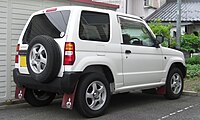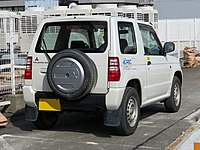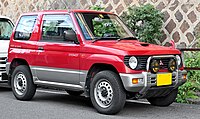Mitsubishi Pajero Mini
| Mitsubishi Pajero Mini | |
|---|---|
 | |
| Overview | |
| Manufacturer | Mitsubishi Motors |
| Also called | Nissan Kix |
| Production | 1994–2012 |
| Assembly | Japan: Kurashiki, Okayama (Mizushima plant) |
| Body and chassis | |
| Class | Kei car |
| Body style | 3-door SUV |
The Mitsubishi Pajero Mini (Japanese: 三菱・パジェロミニ, Mitsubishi Pajero Mini) is a kei car produced by Mitsubishi Motors from December 1994 until June 2012.
Overview[]
Based on the platform of the Minica, the Pajero Mini was styled as a miniature version of the company's successful Pajero sport utility vehicle, in response to the SUV craze of the late 1980s and early 1990s.[1] Compared to the full-sized original, the kei vehicle was considerably smaller and was fitted with petrol 660 cc four-cylinder engines.
The popularity of the vehicle inspired Mitsubishi to create several limited editions, including the "Iron Cross", "Desert Cruiser", "White Skipper" and "Duke".
First generation (1994; H51/56A)[]
| Mitsubishi Pajero Mini H51A/H56A | |
|---|---|
 Mitsubishi Pajero Mini XR-II | |
| Overview | |
| Manufacturer | Mitsubishi Motors |
| Production | 1994–1998 |
| Assembly | Japan: Kurashiki, Okayama (Mizushima plant) |
| Body and chassis | |
| Class | Kei car |
| Body style | 3-door SUV |
| Related | Mitsubishi Pajero Junior |
| Powertrain | |
| Engine | |
| Dimensions | |
| Wheelbase | 2,200 mm (86.6 in) |
| Length | 3,295 mm (129.7 in) |
| Width | 1,395 mm (54.9 in) |
| Height | 1,630 mm (64.2 in) |
| Curb weight | 780–930 kg (1,720–2,050 lb) |
The original Pajero Mini was first presented in December 1994. It was available with a choice of naturally aspirated or turbocharged 659 cc four cylinder engines with 52 or 64 PS (38 or 47 kW). Front- or four-wheel drive were available, with 2WD models receiving the H51A model code and four-wheel drives being H56A. A larger-engined version with a wider track (and correspondingly larger fender flares) was presented in October 1995; this was sold as the Mitsubishi Pajero Junior. The turbocharged models were VR-I or VR-II depending on equipment levels, while the naturally aspirated versions were called XR-I and XR-II. The "-I" versions received little standard equipment and can easily be recognized by their steel wheels, black bumpers and other trim such as door handles and rear view mirrors, and minimal brightwork. The more expensive -II models were usually painted two-tone and often receive alloy wheels and various pieces of chrome trim.
In May 1996 the Pajero Mini "Skipper", a special version for urban and town use, was released. The name is a reference to Mitsubishi's Minica Skipper kei car coupé of the early 1970s. In December 1997, the Pajero Mini Duke was released. This had a somewhat more rugged appearance, including sturdy cladding along the sides and a grille with upright bars, a reference to Jeeps and Mitsubishi's history of license manufacturing the CJ-3B for four-and-a-half decades.
Rear view
Pajero Mini VR-II (turbo); this model is easily recognized by its hood scoop

Interior (XR-II)

A Pajero Mini Duke X-I
Second generation (1998; H53/58A)[]
| Mitsubishi Pajero Mini H53A/H58A | |
|---|---|
 Mitsubishi Pajero Mini Limited (late) | |
| Overview | |
| Manufacturer | Mitsubishi Motors |
| Production | 1998–2012 |
| Assembly | Japan: Kurashiki, Okayama (Mizushima plant) |
| Body and chassis | |
| Class | Kei car |
| Body style | 3-door SUV |
| Powertrain | |
| Engine | |
| Dimensions | |
| Wheelbase | 2,200 mm (86.6 in) |
| Length | 3,395 mm (133.7 in) |
| Width | 1,475 mm (58.1 in) |
| Height | 1,635 mm (64.4 in) |
| Curb weight | 820–990 kg (1,808–2,183 lb) |
In October 1998 the kei car regulations were again updated, and the Pajero Mini was widened and lengthened accordingly at the same time.[2] The "Duke" special model was carried over; it now received a larger, deeper set grille with vertical rather than horizontal bars.
In Japan, the Pajero Mini was sold at a specific retail chain called Galant Shop. Since 2008 Mitsubishi has produced the Nissan Kix (Japanese: 日産・キックス, Nissan Kikkusu), an OEM version of the Pajero Mini, expanding a similar deal already in place for the Mitsubishi eK/Nissan Otti.[3]
Production of the Mitsubishi Pajero Mini ended in June 2012.[4]
Mitsubishi Pajero Mini Right Front

Mitsubishi Pajero Mini Right Back
Mitsubishi Pajero Mini Right Front
Mitsubishi Pajero Mini Left Front
A Pajero Mini Duke
NISSAN KIX

NISSAN KIX RS

Mitsubishi Pajero Mini last model
Annual production and sales[]
| Year | Production | Sales | Exports |
|---|---|---|---|
| 1994 | unknown | unknown | unknown |
| 1995 | 104,990 | unknown | unknown |
| 1996 | 71,185 | unknown | unknown |
| 1997 | 43,302 | 44,224 | 358 |
| 1998 | 48,792 | 47,592 | 32 |
| 1999 | 36,580 | 35,673 | 3 |
| 2000 | 24,895 | 27,011 | 2 |
| 2001 | 16,590 | 17,458 | 0 |
| 2002 | 12,672 | 13,720 | – |
| 2003 | 17,141 | 17,237 | – |
| 2004 | 10,307 | 10,371 | – |
| 2005 | 10,445 | 10,611 | – |
| 2006 | 9,436 | 9,367 | – |
| 2007 | 9,279 | 9,195 | – |
| 2008 | 17,033 | 11,456 | – |
| 2009 | 11,195 | 8,646 | – |
| 2010 | 9,165 | 8,056 | – |
| 2011 | 9,681 | 8,281 | – |
| 2012 | 5,862 | 6,081 | – |
| 32 more cars sold 2013-2017 |
(Sources: Facts & Figures 2000, Facts & Figures 2001, Facts & Figures 2005, Facts & Figures 2009, Mitsubishi Motors website)
References[]
- ^ "Mitsubishi Motors Corporation", Fundinguniverse.com
- ^ "Toppo BJ, Minica, Pajero Mini; New regulation mini-cars from Mitsubishi Motors" Archived 2009-07-16 at the Wayback Machine, Mitsubishi Motors press release, October 5, 1998
- ^ "Nissan Motor Company and Mitsubishi Motors to expand OEM supply agreement for mini-cars" Archived 2009-04-16 at the Wayback Machine, Mitsubishi Motors press release, February 27, 2008
- ^ "三菱自動車、軽乗用車 『パジェロミニ』 の特別仕様車「Premium Selection ~Final Anniversary~」を発売", Mitsubishi Motors press release
External links[]
| Wikimedia Commons has media related to Mitsubishi Pajero Mini. |
- Pajero Mini (Japanese)
- Pajero Mini VR (4WD) specifications, Mitsubishi-motors.com
- 2000s cars
- Mitsubishi Motors vehicles
- All-wheel-drive vehicles
- Kei sport utility vehicles
- Kei cars
- Cars introduced in 1994











